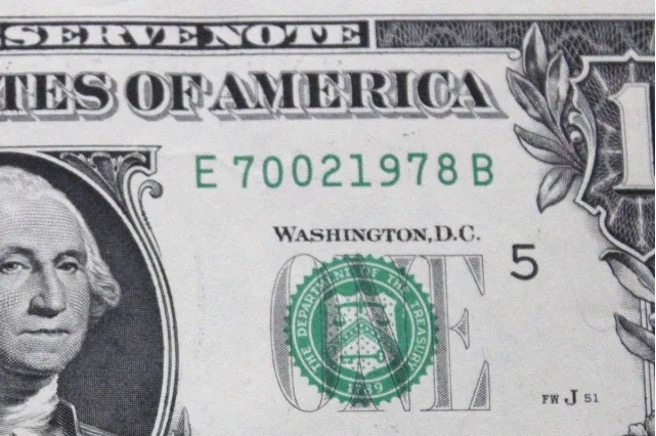
Credit: Chiara Sakuwa/ Alamy Stock Photo
For most people, the only thing that matters about cash is the value printed on each bill and the total amount filling their wallets. But folks with a sharp eye and a little more time on their hands may notice the intricate design details on the various denominations. Along with the portrait of a famous statesman, U.S. currency features a potpourri of images that range from intriguing to downright mystifying.
Perhaps no bills pack a more befuddling display into an innocuous package than the $1 note. The humble dollar bill offers a rich tapestry of symbolism for those who take the time to examine the craftsmanship a little more closely. Here are the explanations behind seven of the dollar bill’s more perplexing elements.
SERIAL NUMBERS
To start with perhaps the least mysterious, the obverse (or front) of the bill features several numbers. The longer ones off to the top right and lower left of George Washington’s portrait are the serial number, with the first letter of each series identifying the Federal Reserve Bank that issued the note. That same letter appears in the middle of the Federal Reserve District seal, to the left of Washington, and also corresponds to the four numbers located near the number “1” at each of the four corners. For example, the Second Federal Reserve District is New York, so a $1 bill from that district would have a prominent “B” within the Federal Reserve District seal and at the front of the two serial numbers, as well as the number “2” near each of the four corners.”
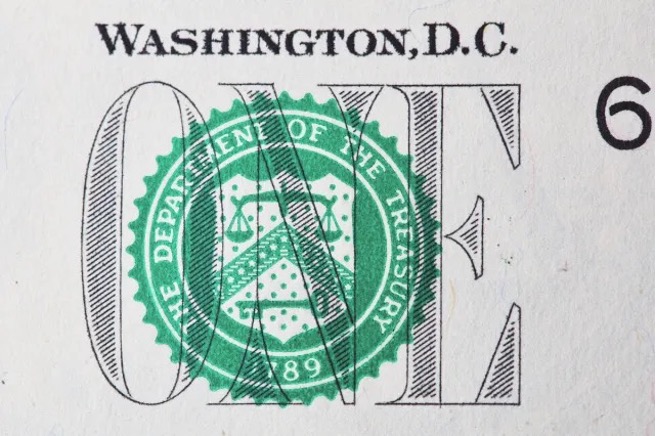
TREASURY SEAL
Also on the front, the green imprint to the right of George Washington is the U.S. Treasury seal. Designed by Francis Hopkinson, a New Jersey delegate to the Continental Congress, the Treasury seal features a set of balanced scales, which represents justice. The inverted “V,” known as a chevron, is lined by 13 stars, symbolic of the original 13 colonies. At the bottom of the seal, the depiction of a key stands for authority.
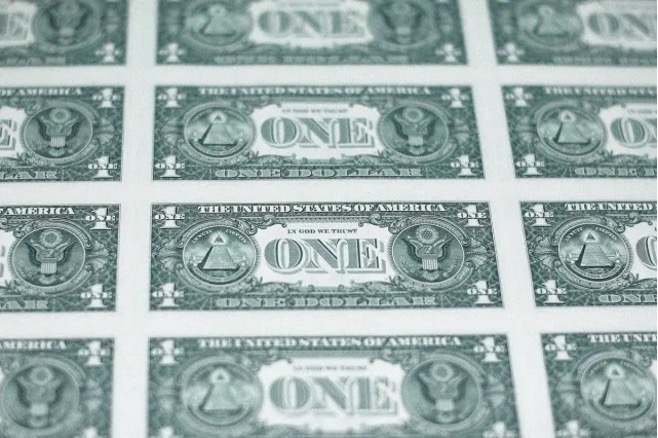
BALD EAGLE
The reverse of the dollar bill features the two sides of the Great Seal of the United States, created in 1782 by Secretary of Congress Charles Thomson from the recommendations of three committees. The front of the seal, to the right of the word “ONE” emblazoned across the middle, features the American bald eagle, wings spread as if in flight. The eagle grips 13 arrows in its left talon, emblematic of war, and an olive branch signifying peace in the right talon. The bird’s head is notably turned in the direction of the olive branch to exemplify the nation’s preference for peace.
Famously, Benjamin Franklin objected to the choice of an eagle as the national symbol; the statesman wrote that he preferred the “more respectable” turkey. The bird’s presentation on currency also proved a source of controversy on one occasion. The 1801 U.S. silver dollar inadvertently showcased the arrows, rather than the olive branch, in the eagle’s right talon, apparently a signal to Europeans that the young nation was primed for war. This misunderstanding was corrected by 1807 when a reissued coin switched the positions of the bundles.
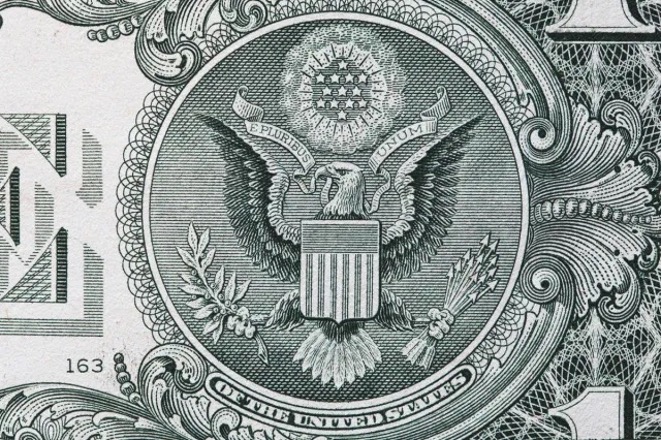
SHIELD
According to Thompson’s official explanation of the design, the shield, or escutcheon, stands in front of the eagle “without any other supporters to denote that the United States of America ought to rely on their own Virtue.” The shield displays 13 vertical lines of alternating shades to represent the first states, which together prop up a horizontal band that stands for the unifying force of Congress. While the bill mostly features varying shades of green and white, the original seal provides even more significance when seen in full color. The vertical lines are alternately red, representing hardiness and valor, and white, for purity and innocence, while the blue horizontal band symbolizes vigilance, perseverance, and justice.
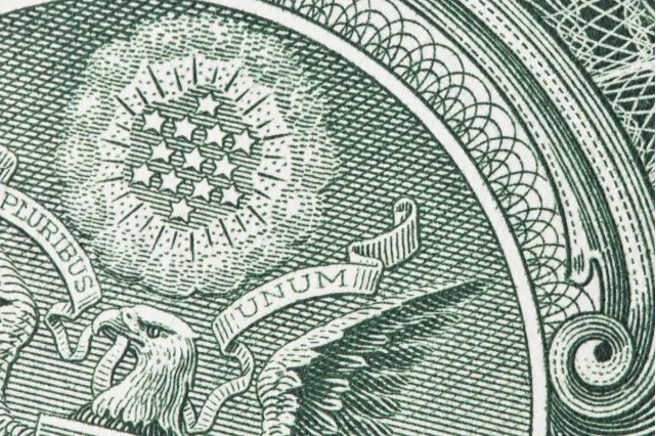
STARS
Above the eagle’s head, a conglomeration of 13 stars floats in the middle of a glory-like display of light and cloud. Again, the 13 stars represent the original 13 colonies, here emerging as a new nation among the world’s sovereign entities as a new constellation would appear among the other stars in the sky.
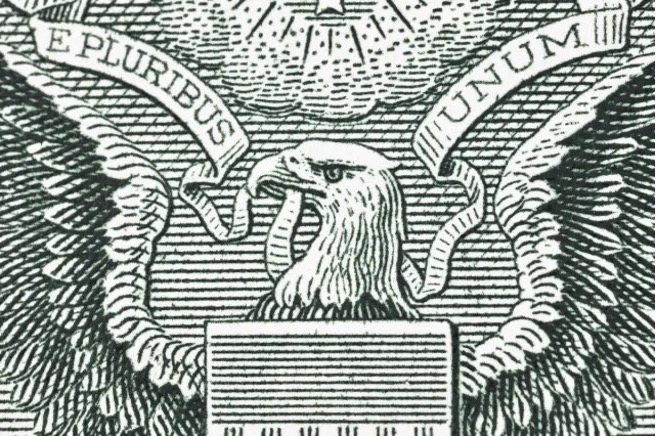
LATIN INSCRIPTIONS
The back of the bill also features several Latin inscriptions. The eagle clutches a scroll in its beak that reads E Pluribus Unum, which translates to “Out of Many, One.” Possibly borrowed from the London-published Gentlemen’s Magazine, which was well known among educated Americans in the late 18th century, the motto encapsulates the cause of the American states. Across the back of the bill, which features the reverse side of the Great Seal, the phrase Annuit Coeptis above the pyramid translates to “Providence Has Favored Our Undertakings.” Below, the inscription Novus Ordo Seclorum, meaning “A New Order of the Ages,” refers to the inception of the U.S. government.
It was in large part that last phrase that resulted in the Great Seal being featured on the dollar bill. While earlier printings had different designs, President Franklin D. Roosevelt believed that the phrase “A New Order of the Ages” would remind the public of his New Deal, resulting in the bill’s reformatting in 1935.
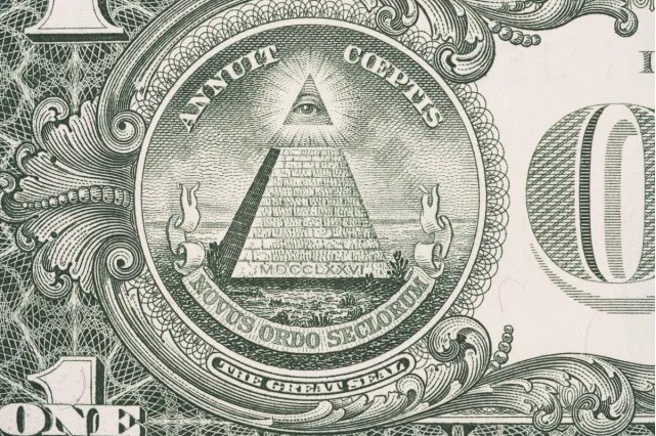
PYRAMID AND EYE
Perhaps the most cryptic and controversial symbols to adorn the dollar bill are the pyramid with its detached capstone and embedded eye. The pyramid signifies “strength and duration,” according to Thompson, though others suggest the structure’s unfinished form represents America’s status as an unfinished creation. The pyramid consists of 13 rows, with the year of the nation’s founding printed in Roman numerals on the lowest level. Meanwhile, the giant floating eye, traditionally known as the Eye of Providence, was explained by the designer as another of the “signal interpositions of providence in favor of the American cause.”
These particular symbols have been fodder for conspiracy theorists who believe U.S. currency is filled with references to shadowy organizations such as the Freemasons. However, the Eye of Providence had already been a well-known Christian symbol of God’s benevolent watchfulness by the time the Great Seal of the United States was created in 1782. The incorporation of both the eye and the pyramid into the Great Seal predated their widespread use among the Freemasons.
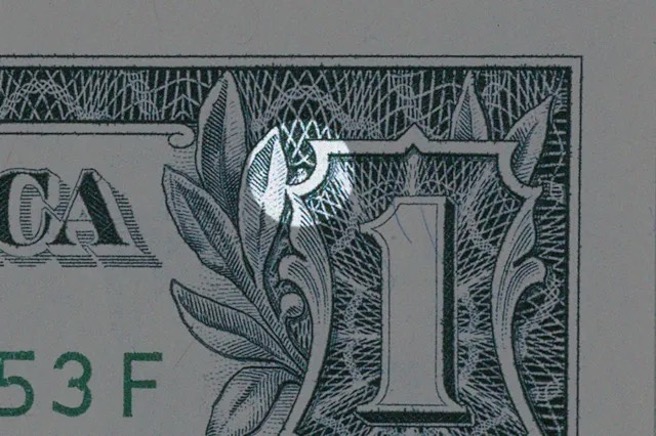
Images Group via Getty Images
BONUS: OWL/SPIDER
Depending on the eye of the beholder, a white speck perched on the top left border of the top right “1” on the front of the bill appears to be a spider or an owl when magnified. Again, this piques the interest of the conspiracy-minded who note that an owl is a symbol of the Illuminati. However, there is no mention of a deliberately created creature in that area among the founding documents, and other sharp-eyed observers have pointed out that this alleged symbol is more likely part of the dollar’s webbed background design.






